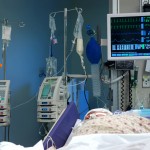
Ventilator-associated pneumonia (VAP) is reported to develop in between 6-52% of ventilated patients. A number of studies and reviews have examined a potential link between VAP and oral hygiene measures.
The aim of this review was to assess whether toothbrushing-based oral health measures, performed in intensive care units, can reduce the risk of ventilator-associated pneumonia (VAP).
Methods
Searches were conducted in the Cochrane Central Register of Controlled Trials (CENTRAL), PubMed, Scopus, Web of Science and OpenGRAY databases. Randomised controlled trials (RCTs) of the use of toothbrushing procedures in intensive care patients undergoing mechanical ventilation were considered. The main outcomes were, the number of patients with ventilator-associated pneumonia, mortality relating to VAP, colonisation of dental plaque by VAP associated bacteria, other outcomes included adverse effects cause by oral health measures. Two reviewers independently selected studies, extracted data and assessed risk of bias using the Cochrane domain-based tool. Dichotomous data were presented as risk ratios (RR) with 95%confidence intervals (CI) and random effects meta-analysis were conducted.
Results
- 12 RCTs involving a total of 2,063 patients were included.
- Studies came from Brazil, China, Iran, Spain, Taiwan, Thailand, UK and USA.
- 2 studies were considered to be at low risk of bias, 6 at unclear risk and 4 at high risk.
- Seven RCTs (58.3%) reported some degree of positive association between toothbrushing measures, and potential reduction of mechanical ventilation‐related outcomes and dental biofilm/oral bacteria.
- Pooled estimates did not identify an additional decrease of VAP incidence for any of the tested procedures
- toothbrushing + Chlorhexidine (CHX )versus swab/gauze cleaning + CHX; RR=1.37 (95%CI; 1.00, 1.87) [4 studies]. or
- toothbrushing + CHX versus toothbrushing alone or + placebo; RR = 1.30 (95%CI; 0.58, 2.91) [4 studies].
- Only 1 study reported on adverse effects of irritation of oral mucosa associated with toothbrushing which was seen in 10 (9.8%) patients.
Conclusions
The authors concluded: –
the results of this SR indicate that toothbrushing does not seem to promote a reduction of VAP‐outcomes, in ICU, compared to swab/gauze cleaning, when topic CHX solutions/gels are applied for oral hygiene of patients submitted to MV. Similarly, the toothbrushing‐based OHM method (ie, toothbrushing alone or associated to topic CHX) did not influence the risk of VAP.
Comments
The Cochrane Oral Health group published a systematic review update in 2016 (Dental Elf -31st Oct 2016) that considered a broader range of oral hygiene methods for critically ill patients. This new review just focuses on those involving toothbrushes. The review includes just 3 studies that are not included in the Cochrane review. Two of the have been published subsequently but the third was excluded from the Cochrane review as it was not designed to assess VAP incidence or mortality although it had been included in previous versions of the review. It is also worth noting that the Cochrane team rated all of the studies common to both reviews as being at high risk of bias.
The Cochrane summary stated:-
We found high quality evidence that chlorhexidine, either as a mouthrinse or a gel, reduces the risk of VAP from 25% to about 19%. For every 17 people on ventilators for more than 48 hours in intensive care, the use of oral hygiene care including chlorhexidine will prevent one person developing VAP. However, we found no evidence that oral hygiene care with chlorhexidine makes a difference to the numbers of patients who die in ICU, or to the number of days on mechanical ventilation or days in ICU.
We have only limited evidence on the effects of toothbrushing (with or without antiseptics) and oral care without toothbrushing (with or without antiseptics) on the risk of developing VAP.
So while this review has identified two additional RCTs involving toothbrushing it does not add significantly to the earlier Cochrane review.
Links
Primary Paper
de Camargo L, da Silva SN, Chambrone L. Efficacy of toothbrushing procedures performed in intensive care units in reducing the risk of ventilator-associated pneumonia: A systematic review. J Periodontal Res. 2019 Jun 17. doi:10.1111/jre.12668. [Epub ahead of print] Review. PubMed PMID: 31206663.
Other references
Dental Elf -31st Oct 2016
Dental Elf – Ventilator-associated pneumonia blogs

Informative , thank you for sharing it